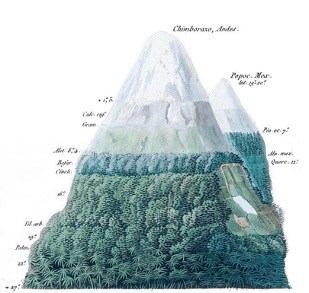Alpine meadows are true islands of biodiversity, bringing a multitude of benefits for our well-being, as humans. We have a historical relationship with alpine meadows, and the abandonment of traditional grazing through transhumance in favour of intensive practices can have unexpected effects on them, especially due to rising temperatures. In the context of climate change, it is important to ask ourselves what kind of benefits we can obtain from these meadows and whether we are able to “see” all of them.
What are alpine meadows?
One-third of the global terrestrial surface is occupied by a type of habitat we generally refer to as grasslands, expansive areas where the dominant vegetation is herbaceous. One category of grasslands is alpine meadows, commonly found at altitudes above 2000 metres.
For those who have ventured to these heights, they are familiar landscapes where many species of plants with aesthetic value are encountered – a value that increases when we realise they are endemic to these places and are rare due to the limited available space, as is the case with the alpine symbol, Leontopodium alpinum or Edelweiss.
The specific conditions of mountainous regions have historically limited their exploitation, leading to the almost intact preservation of species, waters, soils, and geological substrates, making them suitable candidates for conservation. Currently, over a third of the total area of globally protected natural areas is located in mountainous regions. To put it more tangibly, there are over 7 million square kilometres being protected globally in mountains, not counting Antarctica.
Biological diversity is not evenly distributed across the terrestrial surface. As a general rule, it increases with latitude, from the poles to the equator. The process of speciation, where new species arise, is accelerated where the landscape forms ‘islands’, whether true or isolated habitats. Isolation thus leads to an enrichment of biological diversity, resulting in endemism and rare species that occur only in those specific places, a consequence of their adaptation to unique environments.
Mountains — a refuge for a wide range of species
Ecosystems formed by the effect of altitude coincide with those formed by the effect that latitude has on environmental conditions. The variety of organisms is thus compressed within a limited area and an altitudinal gradient, as opposed to a large area and a latitudinal gradient. On an altitudinal gradient, ‘island habitats’ are also formed due to diverse topography and microclimatic conditions.
For those who venture into the mountains more often, it’s no secret that each valley has its own distinct characteristics due to slope exposure, steepness, inclines, and the overall direction of the wind. You could traverse two adjacent valleys in June, encounter snow and patches of ice in one, and suffer from heat in the other. When you add this geographical isolation and mosaic of conditions to natural history, with epochs and eras in which the Earth has ‘changed its attire’ multiple times, it’s no wonder that mountains have served as refuges for a wide range of species.
For our country, Leontopodium alpinum (Edelweiss), which we mentioned earlier, and Dianthus callizonus (Carpathian Pink) are perhaps the most well-known to the general public. These are species that, after the last major glaciation, during which they would have occupied lower altitudes, migrated following the melting glaciers, gradually ascending the mountains, or remained isolated in small populations that over time gave rise to new species.
What altitude do alpine meadows fall under on the vegetation scale?
In the year 1799, a young German naturalist accompanied by a French botanist embarked on an expedition to South and Central America. These two individuals, Alexander von Humboldt and Aimé Bonpland, carried with them a true mobile laboratory throughout their 5-year journey. Using their equipment, they recorded in thousands of field notebooks the physical properties of the environments they encountered, with a particular focus on the plant species surrounding them. One of the significant conclusions drawn from this extensive journey, based on empirical data collected in the mountains, was that the distribution of plants is primarily determined by temperature, not altitude. Von Humboldt was the first to observe that ascending short distances of several tens of kilometres in mountains is equivalent to travelling several thousand kilometres in latitude, towards the poles.
I believe we all learned about vegetation zones since middle school. More than likely, they were presented as zones defined by altitude, although the formation of plant communities is influenced by pedological, climatic, and topographical factors, not just the mere presence of altitude. However, on a larger scale, it’s easy to recognize the changes brought about by altitude. To avoid delving into overly technical details, we can rely on the general temperature decrease with altitude, roughly around 0.65°C per 100 metres of elevation.
This phenomenon constrains species adapted to certain thermal conditions within these vegetation zones. The altitudes presented are general figures, a sort of averages that we currently take as they are, to avoid factors such as humidity, soil type, slope exposure, etc. Thus, in our country, we learned that oak and beech trees are found at altitudes up to 500 metres, followed by beech, which can be found up to 1,300 metres. After that, it disappears, and we encounter only conifers, with spruce dominating, but above 1,600 metres, we enter the subalpine zone. Here, the annual temperatures do not allow tree growth, as they require a certain number of days with a temperature above 6°C to sustain their populations.

Graphic description of vegetation layers identified by von Humboldt on the Chimborazo volcano in the Andes as depicted in De distributione plantarum, published in 1817. Adapted from Korner, 2019.
Beyond this isotherm (a line connecting all points with the same temperature, a term introduced by von Humboldt himself), we will encounter shrub species with a low stature that have the ability to “disconnect” from the atmosphere. In a way, they are no longer dependent on air temperature. Due to their low stature and growth form, they create a microclimate that allows them to maintain higher temperatures around their organs. This is the subalpine zone, where we find junipers, rhododendrons, juniper, and other low-stature woody species. But even these cannot withstand the temperatures usually encountered above 2200 metres of elevation in our country. Here, we will only find herbaceous species that can survive due to a number of specific adaptations acquired in their evolutionary history.
As temperatures rise, the general hypothesis is that the isotherm separating these alpine plants from woody plants (which generally use more resources and replace the dominant species at present) will rise to higher altitudes. For species at lower vegetation levels, this is not a problem as they migrate with temperatures, staying within the conditions to which they are adapted. However, species in the alpine zone will have nowhere to migrate upwards, which could lead to the extinction of many of them. In high mountains like the Alps or the Himalayas, there is another zone above the alpine zone, the nival zone, which is permanently under snow or glaciers. Rising temperatures will lead to their melting and allow the alpine zone species to migrate, but the effects of melting these immense quantities of ice remain a subject for research.
What are ecosystem services?
In the real world, we cannot make decisions regarding how we manage these areas or anthropic activities that may impact them solely based on the intrinsic value of these species. The term “ecosystem services” has entered the specialised literature for half a century and continues a long tradition of convincing decision-makers that resources are not infinite and that systems providing services to humanity should be assessed before intervention.
There are several philosophies and models at work, but we will present the simplest ones, used in CICES, based on three main categories: provisioning services, which are physical resources such as wood, freshwater, fruits, mushrooms, forage, genetic resources, etc.; regulating services, which are benefits to humanity through processes occurring in the respective ecosystems, such as air or water quality regulation, erosion control, wind attenuation, pest population regulation, etc.; cultural services — benefits to people through culture, such as recreation, tourism, improvement in quality of life due to access to green spaces or interactions with nature.
Looking through the lens of ecosystem services, grasslands, in any form and wherever they may be found, contribute to all the aforementioned categories (as indeed most terrestrial ecosystems do, but here, the way the beneficiary population perceives these services matters a great deal).
What kind of ecosystem services do alpine grasslands provide?
Provisioning services: Alpine grasslands serve as a source of forage with minimal investment (where animals are grazed without the need for additional pasture resources) or can be easily converted into agricultural land where water resources allow for farming. However, production seems to be less evaluated than regulating services.
Regulating services: A meta-study assessed the ecosystem services provided by one hectare of grassland at $4,000 to $5,000 annually, depending on its type (semi-arid, tropical, temperate, or Mediterranean), with regulating services weighing the most, averaging four times more. The global services provided by grasslands were estimated at $20.8 trillion annually.
Mountain ecosystems play a significant role in the functioning of complex regional ecosystems at lower altitudes. They influence temperature, precipitation, and control erosion patterns. The soils and plants of these ecosystems act as water reservoirs, ensuring gradual water release. Soil erosion mediated by these plants transports sediments and nutrients to lower-altitude areas. Mountain ecosystems contribute, through their vegetation, to the mitigation or prevention of destructive natural processes such as avalanches or landslides. Over half of the global population benefits from freshwater sourced from mountain ecosystems, where it is captured and purified through biogeochemical processes.
Cultural services: Last but not least, mountains are an important resource for socio-cultural diversity. Through the same isolation processes that have led to taxonomic diversity, human populations living in mountain areas have developed agricultural and pastoral traditions and customs that can be crucial for the sustainable development of these regions. This socio-cultural diversity, coupled with the unique landscape of mountain areas, makes them significant centres for recreation and tourism.
What impact does climate change have on mountain ecosystems and why does it matter?
Temperature increases attributed to anthropogenic climate change are expected to be extreme in high-altitude ecosystems. Experimental studies have shown that the resilience of plant communities in alpine zones can be affected by a single season of extreme high-temperature variations.
Some research on the effects of temperature increases on plant metabolism in alpine communities suggests that an extended growing season leads to increased productivity in these ecosystems, which could be considered positive for provisioning services.
However, these ecosystems can also be affected by drought periods resulting from temperature increases and changes in precipitation. Furthermore, observed climate changes in recent decades underlie a shift in vegetation zones in alpine areas, with plant species from lower zones migrating to higher altitudes, replacing the existing species.
The abandonment of alpine pastures can trigger a new successional stage. If humans or domestic herbivores no longer regularly “mow” the vegetation, woody species can establish themselves where environmental conditions permit. Over a few decades, what was once grassland may turn into a forest, a process that has consequences for the entire ecosystem mosaic.
In the Alps, the negative impact of pasture abandonment on bird species with high conservation value, such as the alpine accentor (Montfrigilla nivalis) or the rock thrush (Monticola saxatilis), which depend on grazed pastures, has been observed. On the other hand, a study in the Bucegi Mountains that focused on vegetation and gastropods with high conservation value highlights the loss of these rare species in grazed areas.
This situation is just one example of the conservation dilemma regarding alpine grasslands. Which species do we want to preserve? What benefits do we want to derive from these areas in the future, areas that we visit so rarely and whose beauty we see more in the geographical landscape than when we carefully observe the vegetative carpet beneath our feet.
How do alpine grasslands evolve in Romania?
While in other mountain ranges such as the Himalayas and the Alps, the issue of tree line advancement (where populations of trees can survive) is better documented, studies in Romania are scarce. Most studies are predictive, meaning they attempt to use the current situation, the climatic requirements of certain species, and climate models based on different atmospheric compositions in the future to get an idea of how alpine grasslands will look in the coming decades. Few studies have tracked the evolution of the relationship between the alpine and lower elevations in our country up to now.
One of these studies, which examined the entire Carpathian chain, reconstructed the tree line (the forest limit) from the end of the 19th century to 2002 and correlated the dynamics of this line with a set of topographic, biotic, and cultural predictors. The results showed that trees advanced, on average, by 56 metres in altitude after 1930, which is 9 metres per decade. The results indicate that a synergy between rising temperatures and pasture abandonment could explain this dynamic.
Another paleobotanist study analysed sediments from Bucura and Lia Lakes in Retezat to study the past tree line. The presence of trees was observed at altitudes over 2,000 metres (in the case of Bucura Lake) as early as the 8th millennium BCE, when temperatures reached a maximum during the Holocene, disappearing in the 1st millennium BCE, when they were replaced by vegetation specific to grasslands. It’s worth noting that the authors attribute the decline of the tree line not only to temperatures but also to human activities, evidenced by pollen brought from lower altitudes found in sediments. Our relationship with the mountains is an old one, and traditional pastoralism seems to be one of the factors that shaped today’s alpine grasslands.
Currently, we are facing a decline in traditional grazing practices in favor of more centralized farming practices across most of Europe, which are less sustainable. At the same time, intensive grazing can lead to significant loss of biodiversity. Taking the extreme example of Latin America, where 57% of the new grasslands created between 2001 and 2013 (almost 100 million hectares) replaced tropical forests, we can realise that how we view grasslands will shape Romania’s biodiversity and inevitably affect the future of the planet. Nationally, we are making progress through projects like the one coordinated by the University of Agricultural Sciences and Veterinary Medicine in Cluj, which aims to promote the sustainable use of grasslands while respecting their biodiversity.
Dilemmas towards sustainable development
Looking towards the future of alpine grasslands in the context of climate change, it is important to ask: how will they change as temperatures rise, and what effect will it have if we completely abandon transhumance in favour of industrialised animal husbandry?
We face this dilemma in several sectors. From an anthropocentric perspective, we will need to decide what benefits we want from grasslands, but the question that will haunt us is, “Have we truly managed to calculate the real benefits?”
Von Humboldt was among the first to formulate the idea of the interconnectedness of all elements in nature. He described nature as a vast web, a network in which all threads are connected in one way or another. He believed that the planet’s balance is the result of the interaction of millions of physical and chemical forces acting on all elements of nature. Von Humboldt was also a pioneer in understanding human impact on the environment. He observed and wrote about the effect that deforestation has on soil erosion and the frequency of floods.
Today, we know more than Von Humboldt did in the early 19th century about how nature functions and how complex the network of all its elements is. However, the knowledge accumulated so far will only be useful if we understand how to use it to achieve the goal of sustainable development and, eventually, to manage the planet’s resources in a sustainable manner.

Costin Enache
Costin is studying alpine vegetation and trying to understand what will happen to those plant species in the future. All of this is happening at the University of Bucharest, Faculty of Biology, as part of a doctoral program. He loves the mountains and is interested in how he can gather more information about the highest ecosystems in our country using satellite remote sensing, in order to make better decisions when it comes to the conservation of mountain ecosystems.
Article first published on InfoClima















